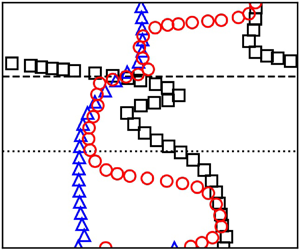Crossref Citations
This article has been cited by the following publications. This list is generated based on data provided by
Crossref.
Tian, Xudong
Liu, Tuo
Wang, Tiantian
Zhu, Jie
and
Wen, Chihyung
2022.
Double-layer acoustic metasurface for the suppression of the Mack second mode in hypersonic boundary-layer flow.
Physics of Fluids,
Vol. 34,
Issue. 7,
Xu, Xiwang
Yi, Shihe
Han, Junhao
Quan, Pengcheng
and
Zheng, Wenpeng
2022.
Effects of steps on the hypersonic boundary layer transition over a cone at 10° angle-of-attack.
Physics of Fluids,
Vol. 34,
Issue. 3,
Guo, Peixu
Shi, Fangcheng
Gao, Zhenxun
Jiang, Chongwen
Lee, Chun-Hian
and
Wen, Chihyung
2022.
Heat transfer and behavior of the Reynolds stress in Mach 6 boundary layer transition induced by first-mode oblique waves.
Physics of Fluids,
Vol. 34,
Issue. 10,
Guo, Peixu
Shi, Fangcheng
Gao, Zhenxun
Jiang, Chongwen
Lee, Chun-Hian
and
Wen, Chihyung
2022.
Sensitivity analysis on supersonic-boundary-layer stability: Parametric influence, optimization, and inverse design.
Physics of Fluids,
Vol. 34,
Issue. 10,
Chen, Yifeng
Guo, Peixu
and
Wen, Chihyung
2023.
Consistent energy-based framework of amplification mechanisms for the second mode in hypersonic boundary layers.
Physics of Fluids,
Vol. 35,
Issue. 12,
Zhuang, Guo-Hui
Wan, Zhen-Hua
Ye, Chuang-Chao
Luo, Zhen-Bing
Liu, Nan-Sheng
Sun, De-Jun
and
Lu, Xi-Yun
2023.
Active transition control by synthetic jets in a hypersonic boundary layer.
Physics of Fluids,
Vol. 35,
Issue. 3,
2023.
Energy growth of vortical, acoustic, and entropic components of the second-mode instability in the hypersonic boundary layer.
Physics of Fluids,
Vol. 35,
Issue. 5,
Chen, Yifeng
Guo, Peixu
and
Wen, Chihyung
2023.
A unified explanation of energy growth sources for unstable modes in flat-plate boundary layers.
Journal of Fluid Mechanics,
Vol. 972,
Issue. ,
Zhuang, Guo-Hui
Wan, Zhen-Hua
Liu, Nan-Sheng
Sun, De-Jun
and
Lu, Xi-Yun
2024.
Instability and transition control by steady local blowing/suction in a hypersonic boundary layer.
Journal of Fluid Mechanics,
Vol. 990,
Issue. ,
Hammachi, Riwan
Piot, Estelle
Deniau, Hugues
Brazier, Jean-Philippe
Daviller, Guillaume
and
Cardesa, José I.
2024.
Coherent structure tracking of the second Mack mode in transitional hypersonic boundary layers.
Journal of Physics: Conference Series,
Vol. 2753,
Issue. 1,
p.
012012.
Grasso, Francesco
and
Gloerfelt, Xavier
2024.
Second-order analysis of hypersonic boundary-layer stability.
Journal of Fluid Mechanics,
Vol. 1000,
Issue. ,
Guo, Peixu
Hao, Jiaao
and
Wen, Chih-Yung
2025.
Understanding Instability-Wave Selectivity of Hypersonic Compression Ramp Laminar Flow.
AIAA Journal,
p.
1.
De Broeck, Lara
Görtz, Simon
Alter, Patrick
Hennings de Lara, João
and
Oberlack, Martin
2025.
Instability damping and amplification of compressible boundary layers via acoustic wall impedance.
Journal of Fluid Mechanics,
Vol. 1007,
Issue. ,
